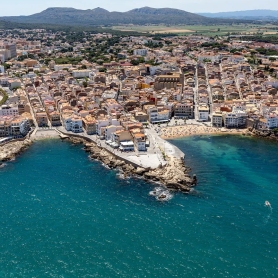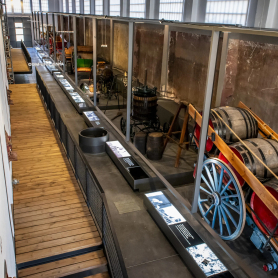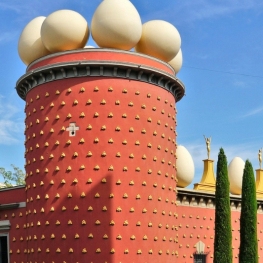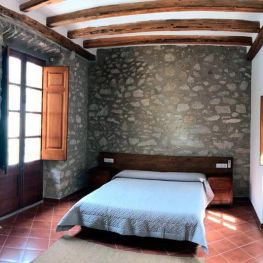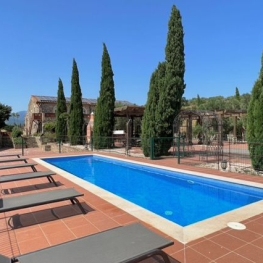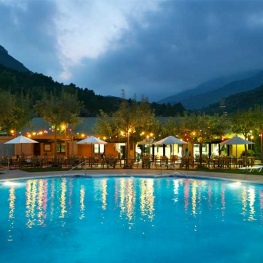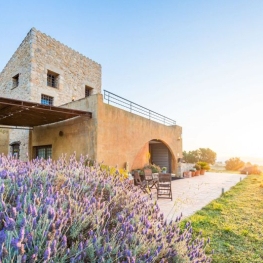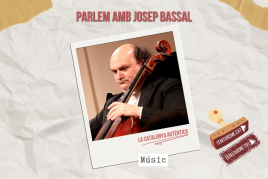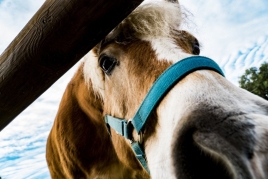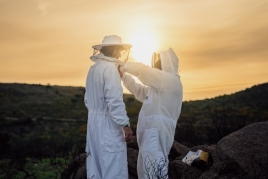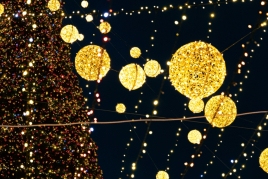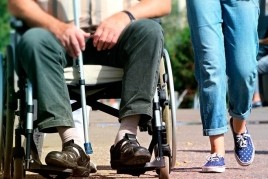The exile in the Jonquera, the route of the republicans towards France
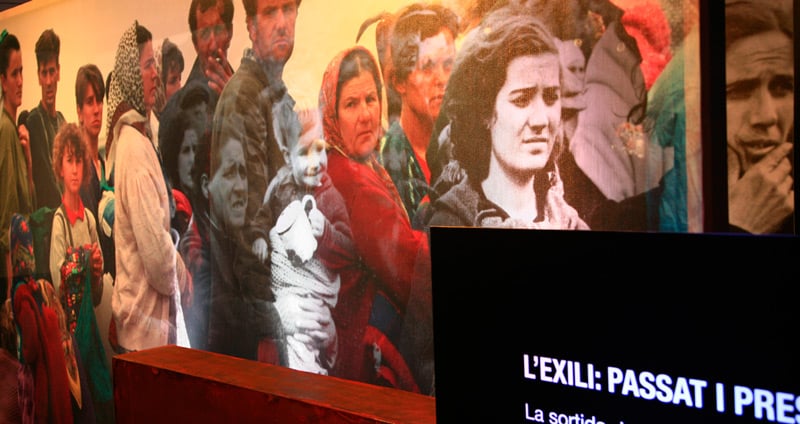
The Civil War, that lasted from 1936 to 1939, meant the confrontation between the supporters and the opposers to the democratic government of the Republic. The conflict ended with the victory of opponents to the Republic, this end meant that thousands of Republicans had to flee Spain to France to avoid the reprisals of the new Franco dictatorship.
The exiles crossed the border on foot, one of the points of passage was around the town of La Junquera, this route runs through the places where the exiles passed, remembering a dramatic phenomenon that today, in our country, is a distant fact in the But in many other countries it remains the present.
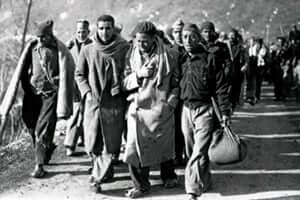 On July 18, 1936 a part of the Spanish army, led by generals Franco and Mola, rose in disagreement with the government of the Spanish Republic, democratically elected at the polls. This revolt was followed by a bloody civil war that lasted from 1936 to 1939, three years that ended with the victory of the opposers to the Republic, the so-called national side. At the end of the war, thousands and thousands of people from the republican side were forced to flee to France, beginning an exile that for many would be long or final.
On July 18, 1936 a part of the Spanish army, led by generals Franco and Mola, rose in disagreement with the government of the Spanish Republic, democratically elected at the polls. This revolt was followed by a bloody civil war that lasted from 1936 to 1939, three years that ended with the victory of the opposers to the Republic, the so-called national side. At the end of the war, thousands and thousands of people from the republican side were forced to flee to France, beginning an exile that for many would be long or final.
The geographical situation of Catalonia, next to France and turned into one of the last territories of the Republic occupied by the national side, caused that they took refuge a great number of republicans of all the territory that, at the moment of ending the war fled massively By the various crossing points of the border with France, one of these places was around the municipality of La Jonquera. From there you can start a route to the border that allows you to remember the route where the Republicans fled and to know the vestiges that still witness today all that historical episode.
La Jonquera
 The route will begin in the municipality of La Jonquera, there, on Calle Mayor 43-47, there is the Memorial Museum of Exile, inaugurated in 2007 and dedicated to remember and explain republican exile, an equipment that forms part of the extensive Network of Spaces of the Memory of Catalonia. The museum has a permanent exhibition with several sections, one part is dedicated to show a general consideration about the exile, not only the republican side, another area reminiscent of the Civil War, defeat and republican retreat. In addition the museum also devotes a part of the exhibition to explain to which countries were the bulk of the republican exiles and what historical facts and contexts were found. Finally, the museum dedicates a section to show the legacy of the exile, showing several documents and objects related to this fact.
The route will begin in the municipality of La Jonquera, there, on Calle Mayor 43-47, there is the Memorial Museum of Exile, inaugurated in 2007 and dedicated to remember and explain republican exile, an equipment that forms part of the extensive Network of Spaces of the Memory of Catalonia. The museum has a permanent exhibition with several sections, one part is dedicated to show a general consideration about the exile, not only the republican side, another area reminiscent of the Civil War, defeat and republican retreat. In addition the museum also devotes a part of the exhibition to explain to which countries were the bulk of the republican exiles and what historical facts and contexts were found. Finally, the museum dedicates a section to show the legacy of the exile, showing several documents and objects related to this fact.
Along with the permanent exhibition you can also find temporary exhibitions related to wars and exiles.
Agullana
Once we have visited the Exile Memorial Museum we will know the memories of the Republican exile on the ground, to do it we will leave La Jonquera, and we will go to Agullana. There you can find constructions that were used by the Government of the Spanish Republic, one of them is the house of Can Bech, in the street of Bech de Careda number 5, was the headquarters of the General Staff of the Republic.
Outside of Agullana, 5 kilometers from the town if we follow the road in the direction of La Vajol, we find the Mas de Can Bech de baix, in this house hosted the President of the Government of the Republic, Juan Negrín. The stay of the president in this place was finished after the Francoist bombing in this house the 4 of February, the pro-Franco group had learned that it was there thanks to the French press. The president himself had to take refuge in a nearby forest and the next day he left Spain. In this way, for a few days, Agullana became the capital of the Republic.
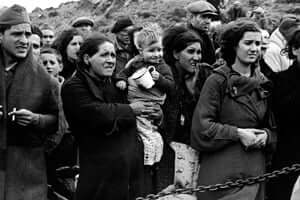 Once we have visited the town, we head for La Vajol, just out of Agullana, on a hill, we will see the Mas Perxès, a building with historical significance, where, during the republican retreat, several intellectuals and the President of the Generalitat, Lluís Companys, with almost all the councilors, some deputies of the Parliament and the president of the Basque government, Jose Antonio Aguirre. Among the group of intellectuals, writers and artists linked to the Ministry of Culture - headed by Carles Pi i Sunyer - stood out Pompeu Fabra, Pau Vila, Pere Bosch and Gimpera, Joan Oliver and Mercè Rodoreda, all of them spent in it some night between the 30 of January and 5 of February of 1939 making a stop in its way towards the exile.
Once we have visited the town, we head for La Vajol, just out of Agullana, on a hill, we will see the Mas Perxès, a building with historical significance, where, during the republican retreat, several intellectuals and the President of the Generalitat, Lluís Companys, with almost all the councilors, some deputies of the Parliament and the president of the Basque government, Jose Antonio Aguirre. Among the group of intellectuals, writers and artists linked to the Ministry of Culture - headed by Carles Pi i Sunyer - stood out Pompeu Fabra, Pau Vila, Pere Bosch and Gimpera, Joan Oliver and Mercè Rodoreda, all of them spent in it some night between the 30 of January and 5 of February of 1939 making a stop in its way towards the exile.
It is estimated that a total of 300 people stayed there during the days of Republican exile, and on January 27, 1939, the Institution of Catalan Letters celebrated its last meeting in Catalan territory.
This building hides another curiosity, in the year 2000 was a valuable set of documents related to the Republican Generalitat that had been forgotten and hidden for 60 years. The documents had been accidentally hidden in the debris of the house chapel, damaged during the war.
La Vajol
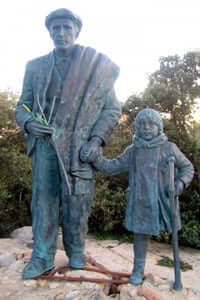 We go to La Vajol where we will be able to know more places related to the route that followed the exiles to arrive until France. At the entrance of La Vajol we will find a car park, there is an indication that will explain the path that we have to follow to go to the Monument to the exile, this tribute to the exiles consists of a bronze sculpture. These are figures representing a man and his daughter, the girl had lost a leg because of a Francoist bombing in Aragon in November 1937. This sculpture is based on real people as part of a photograph made by a journalist Foreigner during the follow-up of the way of the exiles.
We go to La Vajol where we will be able to know more places related to the route that followed the exiles to arrive until France. At the entrance of La Vajol we will find a car park, there is an indication that will explain the path that we have to follow to go to the Monument to the exile, this tribute to the exiles consists of a bronze sculpture. These are figures representing a man and his daughter, the girl had lost a leg because of a Francoist bombing in Aragon in November 1937. This sculpture is based on real people as part of a photograph made by a journalist Foreigner during the follow-up of the way of the exiles.
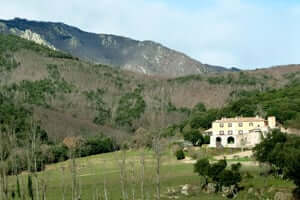 Another of the places of reference of the exile, in the outskirts of La Vajol, is Can Barris, a great house where the president of the Spanish Republic, Manuel Azaña was lodged, just before leaving for the exile. To get there, take the road from La Vajol to Maçanet de Cabrenys until we find the detour.
Another of the places of reference of the exile, in the outskirts of La Vajol, is Can Barris, a great house where the president of the Spanish Republic, Manuel Azaña was lodged, just before leaving for the exile. To get there, take the road from La Vajol to Maçanet de Cabrenys until we find the detour.
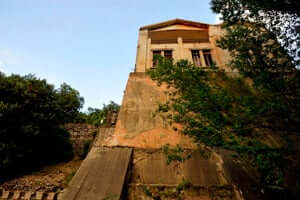 Another place of importance is the mine Canta or Negrín. This was a mine that, during the end of the Civil War, had another function, the president of the Government of the Republic, Juan Negrín, confiscated it and sent to keep in it a consignment of works of art of the Prado Museum to protect them from the Francoist bombings, in addition, also saved a treasure of five hundred million dollars that later would be embarked towards Mexico. Due to its poor condition, the mine is currently closed to the public, but you can still reach the entrance following the detour on the road to La Vajol in Maçanet de Cabrenys, once past the turnoff of Can Barris.
Another place of importance is the mine Canta or Negrín. This was a mine that, during the end of the Civil War, had another function, the president of the Government of the Republic, Juan Negrín, confiscated it and sent to keep in it a consignment of works of art of the Prado Museum to protect them from the Francoist bombings, in addition, also saved a treasure of five hundred million dollars that later would be embarked towards Mexico. Due to its poor condition, the mine is currently closed to the public, but you can still reach the entrance following the detour on the road to La Vajol in Maçanet de Cabrenys, once past the turnoff of Can Barris.
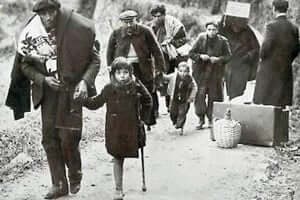 After this part of the visit we will go to Coll de Lli, to get there we have to return to La Vajol and take the GI-505 road towards Ceret, after 1.5 km we will arrive at the restaurant Manrella-Comaulis, at this point We can leave the vehicle since we will have to continue the route on foot. There we will find the pointers towards the Coll de Lli and we will have to walk about 30 minutes to reach it.
After this part of the visit we will go to Coll de Lli, to get there we have to return to La Vajol and take the GI-505 road towards Ceret, after 1.5 km we will arrive at the restaurant Manrella-Comaulis, at this point We can leave the vehicle since we will have to continue the route on foot. There we will find the pointers towards the Coll de Lli and we will have to walk about 30 minutes to reach it.
Once we arrive at a small hamlet that is next to the road we will have to continue in direction towards the French town of the Illes, a few meters we will find an esplanade with a closing made with a wire. This point is the frontier with France and, therefore, the coll de Lli, thousands of exiled anonymous people passed by here , as well as other people known as the presidents of the Republic Manuel Azaña, the president of the Spanish government, Juan Negrín, The President of the Generalitat, Lluís Companys, and the President of the Basque Government, José Antonio Aguirre. In this border point so symbolic can be found a plaque of homage to the presidents and other republican exiles who followed this road to exile.
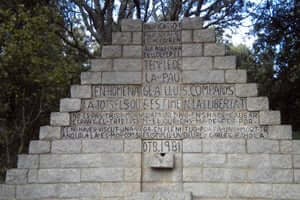 After visiting the Coll de Lli we go to another place of homage, the neck of Manrella, to arrive we will return by the same place where we have come to take the car again and the GI-505 in direction Ceret, we will continue along this road until To arrive at the detour where it indicates Monument to Lluís Companys. As its name indicates this is a place dedicated to the figure of the president of the Generalitat Republican. It is located in another border point and, despite not being the place where Companys happened, it was constructed here because it is a more accessible and ample place than the Coll de Lli. It was built in 1981 by the Commission of Acts in Memory of President Companys, every October 15, the anniversary of his execution, a tribute to the monument is organized.
After visiting the Coll de Lli we go to another place of homage, the neck of Manrella, to arrive we will return by the same place where we have come to take the car again and the GI-505 in direction Ceret, we will continue along this road until To arrive at the detour where it indicates Monument to Lluís Companys. As its name indicates this is a place dedicated to the figure of the president of the Generalitat Republican. It is located in another border point and, despite not being the place where Companys happened, it was constructed here because it is a more accessible and ample place than the Coll de Lli. It was built in 1981 by the Commission of Acts in Memory of President Companys, every October 15, the anniversary of his execution, a tribute to the monument is organized.
At this point we finish the route of exile, an emotional journey that allows us to relive some dramatic events that marked the history of Catalonia and Spain during the twentieth century, an exodus that, despite the distance in time, still keeps very Alive.
You may also be interested in: The Civil War, exile and repression in Catalonia
What to do
Espai Museístic Vi.Vent
Capmany (a 6.3 Km)The Vi.Vent Museum Space in Capmany is much more than an exhibition…
Teatre-Museu Dalí
Figueres (a 16.9 Km)Get to know the artist hidden behind the facade of his mustache…
Where to sleep
Hostal Can Xicu
Capmany (a 6.2 Km)Can Xicu, restored in 2017, preserves the medieval feel of the house.…
Mas Renart
Mollet de Peralada (a 11.7 Km)Enjoy and relax at the Mas Renart Rural House. For groups and…
Càmping Bassegoda Park
Albanyà (a 13.2 Km)Enjoy the sky and the stars in a 1st category family campsite…
Casa Rural Mas Coquells
Vilanant (a 13.5 Km)Enjoy a relaxing holiday on the Costa Brava, in the countryside, on…


